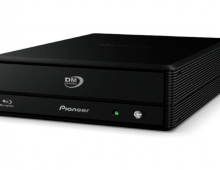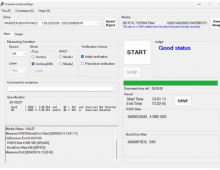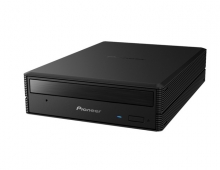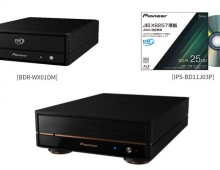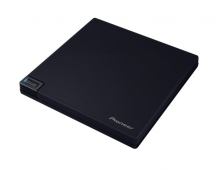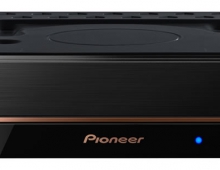
Pioneer DVR-X162J Ships in Japan
Pioneer will release the external DVR-X162J DVD birner in Japan in the beginning of December.
The USB2.0 drive is based on the company's internal S16J model, delivers write speed of 20X, offer enhanced 12X writing speeds for Dual / Double Layer media and include special features to reduce noise, advance write performance and support a wide range of high-speed media.
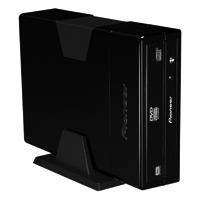 A key feature of the new writers is the ability to support an extensive range of 16X media for 16X, 18X and 20X writing speeds.
A key feature of the new writers is the ability to support an extensive range of 16X media for 16X, 18X and 20X writing speeds.
The new drive also supports a function that Pioneer is calling "Optimal Write Speed" setting. This will be user-selectable via a software utility. Instead of defaulting to the "highest possible writing speed" for a specific media, the optimal write speed feature will switch to a mode which writes at a speed that gives the "best possible quality writing".
Even though the drives can write to media at high speed, all media have been optimised for burning at a specific speed. The Optimal Write Speed setting will write at the speed it has calibrated as the "best quality" for the media inserted in the drive.
The DVD writers also reduce operational noise. This is achieved through two innovations. First, the airflow within the unit has been improved. This enables air to easily circulate around the internal chassis, reducing noise caused by the build-up of air. Second, the drives have been re-designed to prevent the escape of air, especially through the front bezel, that can create significant amounts of background noise. With overlapping chassis joints, it's harder for the air to escape resulting in quiet operation.
PowerRead: There is a difference between how AV and PC handle discs that are difficult to read.In a standard PC environment, DVD-Video is treated as 1 type of data, therefore, if a section is deemed unreadable, playback will stop. With PowerRead, the user-experience is similar to the AV side, making it possible to play the remainder of the disc. Note that with PowerRead, unreadable contents remain unreadable. PowerRead skips to the next readable address.
In addition, the drive features the "PURE READ" function, to compensate the noise introduced when a scratched or dusty audio CD is reproduced. The idea behind PURE READ is to try and correct damaged sectors which are read from the Audio-CD. The feature re-reads damaged sectors to see if it can recover them (I.E. when ripping an Audio-CD). When these damaged sectors are read in a normal scenario, the sector may well be read without any serious error, but sometimes pops or crackles can be heard in the final ripped file. When a sector that is difficult to read is detected, the laser tries to re-read the damaged sector. Not just re-reading the sector, but the drive will actually adjust its read parameters (I.E. higher or lower laser power and the angle of the laser beam are adjusted) to try and get the best-possible read-back from that damaged sector. An algorithm calculates the "best" or "average" result it achieves, and that information (I.E. the best-possible result) is then used as part of the final ripped MP3 file. Re-reading of damaged sectors can be up to a maximum of 40 times.
Additional key write specifications include: 20X speed on DVD-R and +R, 12X on DVD-R DL and +R DL, 6X on DVD-RW and 8X on +RW while CD-R and CD-RW media are catered for at 40X and 32X speeds respectively. In addition, DVR-X162J the multi-format writer also writes at 12X speed to DVD-RAM media.
The drive's size is 166?235?55.8mm (W x D x H) and its weight is 1.23kg.
 A key feature of the new writers is the ability to support an extensive range of 16X media for 16X, 18X and 20X writing speeds.
A key feature of the new writers is the ability to support an extensive range of 16X media for 16X, 18X and 20X writing speeds.
The new drive also supports a function that Pioneer is calling "Optimal Write Speed" setting. This will be user-selectable via a software utility. Instead of defaulting to the "highest possible writing speed" for a specific media, the optimal write speed feature will switch to a mode which writes at a speed that gives the "best possible quality writing".
Even though the drives can write to media at high speed, all media have been optimised for burning at a specific speed. The Optimal Write Speed setting will write at the speed it has calibrated as the "best quality" for the media inserted in the drive.
The DVD writers also reduce operational noise. This is achieved through two innovations. First, the airflow within the unit has been improved. This enables air to easily circulate around the internal chassis, reducing noise caused by the build-up of air. Second, the drives have been re-designed to prevent the escape of air, especially through the front bezel, that can create significant amounts of background noise. With overlapping chassis joints, it's harder for the air to escape resulting in quiet operation.
PowerRead: There is a difference between how AV and PC handle discs that are difficult to read.In a standard PC environment, DVD-Video is treated as 1 type of data, therefore, if a section is deemed unreadable, playback will stop. With PowerRead, the user-experience is similar to the AV side, making it possible to play the remainder of the disc. Note that with PowerRead, unreadable contents remain unreadable. PowerRead skips to the next readable address.
In addition, the drive features the "PURE READ" function, to compensate the noise introduced when a scratched or dusty audio CD is reproduced. The idea behind PURE READ is to try and correct damaged sectors which are read from the Audio-CD. The feature re-reads damaged sectors to see if it can recover them (I.E. when ripping an Audio-CD). When these damaged sectors are read in a normal scenario, the sector may well be read without any serious error, but sometimes pops or crackles can be heard in the final ripped file. When a sector that is difficult to read is detected, the laser tries to re-read the damaged sector. Not just re-reading the sector, but the drive will actually adjust its read parameters (I.E. higher or lower laser power and the angle of the laser beam are adjusted) to try and get the best-possible read-back from that damaged sector. An algorithm calculates the "best" or "average" result it achieves, and that information (I.E. the best-possible result) is then used as part of the final ripped MP3 file. Re-reading of damaged sectors can be up to a maximum of 40 times.
Additional key write specifications include: 20X speed on DVD-R and +R, 12X on DVD-R DL and +R DL, 6X on DVD-RW and 8X on +RW while CD-R and CD-RW media are catered for at 40X and 32X speeds respectively. In addition, DVR-X162J the multi-format writer also writes at 12X speed to DVD-RAM media.
The drive's size is 166?235?55.8mm (W x D x H) and its weight is 1.23kg.

